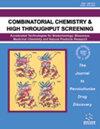Exploring the Potential Role of Sophora alopecuroides L. in Inflammation of Bovine Mammary Epithelial Cells Induced by Lipoteichoic Acid Based on Network Pharmacology and Experimental Validation
IF 1.6
4区 医学
Q4 BIOCHEMICAL RESEARCH METHODS
Combinatorial chemistry & high throughput screening
Pub Date : 2024-09-18
DOI:10.2174/0113862073313036240829070704
引用次数: 0
Abstract
Aim: This study aimed to investigate the anti-inflammatory effect and mechanism of Sophora alopecuroides L. (KDZ) on lipoteichoic acid (LTA)-induced inflammation in Bovine Mammary Epithelial Cells (BMEC). Method: The KDZ active ingredient database was established by using ultra-high-performance liquid chromatography quadrupole time-of-flight mass spectrometry (UPLC-QTOF-MS) to detect the chemical components of KDZ and combine it with the TCMSP database. Furthermore, potential targets of KDZ active ingredients were collected through the UniProt database, and mastitis-related targets were screened through the OMIM, Genecard, and DisGeNET databases. Furthermore, common targets were identified between ingredient targets and disease targets, and protein-protein interaction analysis was performed on them using the STRING platform. Furthermore, the protein interaction network was constructed using Cytoscape software. Core targets were screened through network topology analysis. On this basis, GO and KEGG enrichment analyses were performed on the common target, and molecular simulation docking analysis was conducted on the main active ingredients and core targets. Finally, the accuracy of the network analysis results was validated using in vitro cell experiments. Result: The results of UPLC-QTOF-MS detection and network pharmacology analysis showed that KDZ could intervene in signaling pathways, such as the IL-17 signaling pathway, TNF signaling pathway, MAPK signaling pathway, etc., by acting on 80 common targets through 15 potential active ingredients, thereby regulating biological processes, such as positive regulation of peptidyl serine physiology, apoptotic process, and inflammatory response, to treat mastitis. Besides, molecular simulation docking analysis also showed that the main active ingredients in KDZ, such as quercetin, matrine, calycosin, etc., can form stable bindings with 11 core targets (TNF-α, IL-6, IL-1β, etc.) through hydrogen bonding. Further in vitro validation experiments confirmed that KDZ intervention could inhibit the IL-17 signaling pathway by inhibiting the expression of GSK3β and subsequently inhibiting the production of downstream inflammatory cytokines IL-8, IL-6, IL-1β, and TNF-α, thereby alleviating LTA-induced BMEC inflammatory damage. Conclusion: KDZ can alleviate LTA-induced BMEC inflammatory damage by inhibiting the IL- 17 signaling pathway. This study can provide a scientific basis for the clinical application of KDZ and lay the foundation for the development of new therapeutic drugs for mastitis.基于网络药理学和实验验证,探索槐花在脂溢菜酸诱导的牛乳腺上皮细胞炎症中的潜在作用
目的:本研究旨在探讨白花槐(KDZ)对脂肪胞二酸(LTA)诱导的牛乳腺上皮细胞(BMEC)炎症的抗炎作用及其机制。研究方法采用超高效液相色谱-四极杆飞行时间质谱(UPLC-QTOF-MS)检测KDZ的化学成分,并与TCMSP数据库相结合,建立了KDZ有效成分数据库。此外,还通过 UniProt 数据库收集了 KDZ 活性成分的潜在靶标,并通过 OMIM、Genecard 和 DisGeNET 数据库筛选了乳腺炎相关靶标。此外,还确定了原料靶标和疾病靶标之间的共同靶标,并利用 STRING 平台对其进行了蛋白质-蛋白质相互作用分析。此外,还使用 Cytoscape 软件构建了蛋白质相互作用网络。通过网络拓扑分析筛选出核心靶标。在此基础上,对共同靶点进行了 GO 和 KEGG 富集分析,并对主要活性成分和核心靶点进行了分子模拟对接分析。最后,利用体外细胞实验验证了网络分析结果的准确性。结果UPLC-QTOF-MS检测和网络药理学分析结果表明,KDZ可通过15种潜在有效成分作用于80个共同靶点,干预IL-17信号通路、TNF信号通路、MAPK信号通路等信号通路,从而调控肽丝氨酸生理、细胞凋亡过程、炎症反应等生物学过程,治疗乳腺炎。此外,分子模拟对接分析还表明,KDZ中的主要活性成分,如槲皮素、马钱子碱、萼苷等,可通过氢键与11个核心靶点(TNF-α、IL-6、IL-1β等)形成稳定的结合。进一步的体外验证实验证实,KDZ的干预可以通过抑制GSK3β的表达来抑制IL-17信号通路,进而抑制下游炎症细胞因子IL-8、IL-6、IL-1β和TNF-α的产生,从而减轻LTA诱导的BMEC炎症损伤。结论KDZ可通过抑制IL- 17信号通路减轻LTA诱导的BMEC炎症损伤。本研究可为 KDZ 的临床应用提供科学依据,并为开发治疗乳腺炎的新药奠定基础。
本文章由计算机程序翻译,如有差异,请以英文原文为准。
求助全文
约1分钟内获得全文
求助全文
来源期刊
CiteScore
3.10
自引率
5.60%
发文量
327
审稿时长
7.5 months
期刊介绍:
Combinatorial Chemistry & High Throughput Screening (CCHTS) publishes full length original research articles and reviews/mini-reviews dealing with various topics related to chemical biology (High Throughput Screening, Combinatorial Chemistry, Chemoinformatics, Laboratory Automation and Compound management) in advancing drug discovery research. Original research articles and reviews in the following areas are of special interest to the readers of this journal:
Target identification and validation
Assay design, development, miniaturization and comparison
High throughput/high content/in silico screening and associated technologies
Label-free detection technologies and applications
Stem cell technologies
Biomarkers
ADMET/PK/PD methodologies and screening
Probe discovery and development, hit to lead optimization
Combinatorial chemistry (e.g. small molecules, peptide, nucleic acid or phage display libraries)
Chemical library design and chemical diversity
Chemo/bio-informatics, data mining
Compound management
Pharmacognosy
Natural Products Research (Chemistry, Biology and Pharmacology of Natural Products)
Natural Product Analytical Studies
Bipharmaceutical studies of Natural products
Drug repurposing
Data management and statistical analysis
Laboratory automation, robotics, microfluidics, signal detection technologies
Current & Future Institutional Research Profile
Technology transfer, legal and licensing issues
Patents.

 求助内容:
求助内容: 应助结果提醒方式:
应助结果提醒方式:


